
Electronic Keyers and Paddles: (1940’s - present)
Many different kinds of electronic keyers were marketed during this time interval. With very few exceptions, they are too recent and common to qualify as collectibles. The solid-state ones by Heathkit, Palomar, MFJ, Ten-Tec, etc. are very common. [302]

The Mon-Key Electronic Keyer: ( 1947-1958 )
This early vacuum tube type electronic keyer was one of the first to be made. It was made by the Electric Eye Equipment Co. It used a resistive line cord and no transformer so the raw AC voltage on the keyer contacts could be deadly even though they were partially protected by a plastic cover. [304]

El-Key Paddles: ( 1960’s )
These massive paddles are fairly hard to find. They were made by Robert Poucel W2AYJ on Long Island. (Black and Grey bases) [310]

Autronic Paddles: ( 1960’s )
Several models of these interesting and complex paddles were made by Electrophysics Corp. of Newport Beach, CA. [320]

Brown-Brothers Paddles:
Brown Brothers made paddles & paddle/straight key combinations. This CTL is one of the rarer ones. [330]

FYO Paddles:
These are hard to find and VERY popular. Single [340] (Shown) and Double lever [341] models. were made. (W2PM collection)

Kungsimport "Ugly" Paddles:
These extremely ugly paddles were made using a hacksaw blade with the teeth still in place. [350]
Other Paddles:
Other modern paddles made by Bencher, Ham-Key, MFJ, Ten-Tec, etc. are Very common. [360]
SPARK AND WIRELESS KEYS ( 1900 - 1920’s )
Marconi’s early spark transmitters used a transformer to step up the low battery voltages in the primary to the high voltages in the secondary which were necessary to produce a spark that could radiate signals through the air. Telegraph keys were used to "key" the primary circuit. As the transmitters became bigger and the primary currents became higher, it was soon found that the tiny 1/32 inch contacts on land line keys could not carry the very high primary currents and quickly melted away.
During this period, telegraph keys with larger and larger contacts were developed. These contacts were often made of silver and some could be unscrewed for easy replacement. Some of these large contacts were even equipped with cooling fins. Large spark keys are quite scarce. This is hard to explain since there were many thousands of transmitting stations.

Marconi Spark Key as Used on the Titanic: (1910 - 1920’s)
This lovely Marconi key is just like the ones used on the Titanic. It is made in the classic European style with a heavy straight lever and a tension or "pull-down" spring to keep the contacts separated until the operator pressed the key. [402] (W2PM collection)

Marconi Miniature Spark Key:
This small key was used to operate some of the lower powered Marconi System transmitters. The long legs allowed it to be screwed to the operating table. [406]

Marconi Roadmap Spark Key:
This small spark key was nicknamed the "roadmap key" because the parts are electrically interconnected by copper strips that look a little like like a road map. [408]

Counterfeit / Fake Marconi Spark Key:
This key is a near-perfect reproduction of a Marconi CM-425 Spark Key. It was made by a man who specializes in making reproduction spark keys. The major difference between this counterfeit key [410] and a genuine Marconi key [412] is that the label of this key has engraved lettering and a Marconi key has embossed lettering. The only counterfeit keys that have shown up so far have been Big, Valuable, (mostly Marconi) spark keys but this might change in the future as keys become more widely recognized and valued collectables.

High Power Marconi Spark Key:
This Huge key was designed to key the primary circuit of a 5 KW Navy spark transmitter. The oversize silver contacts have been surrounded with cooling fins to help dissipate the heat generated as they make and break the high current circuit. [414] (From the Jim and Felicia Kreuzer Collection)

Counterfeit Massie Spark Key:
This massive and magnificent spark key [416] is a nearly exact copy of the real ones [418] which were used to key the powerful Massie System Spark Transmitters. It was sold as a genuine Massie key. It is one of the few counterfeit keys that have been reported. (Mostly Marconi spark keys).

The Counterfeit Massie Key Label:
(The poor quality sand casting helps show that it is a reproduction.)

Massie Spark Key:
A genuine Massey Spark Key of different design [420](From the W2PM Collection)

U. S. Navy SE-68 Spark Key from WW-I:
This key was used on a WW-I destroyer on anti-submarine patrol in the North Atlantic. [422]
Documentation of the history or "provenance" of a key generally adds about 30%-50% to its value.

U. S. Navy SE-68A-like Keys:
A batch of these SE-68A-like keys were found new in the box in the Philadelphia Navy Base. [424] The ribbed cast lever is different from the classic SE-68 and SE-68A lever shown above.

Wireless Specialties SE-653 Flameproof Spark Key:
This unusual key is similar to the larger Marconi SE-86 Spark key.It’s contacts were enclosed within a metal cover to allow it to be used in explosive environments. [426] (W2PM Collection)

Miniature Wireless Specialties Spark Key:
This is a small key made by Wireless Specialties Co. It does not have any label but it appears in their literature. [428]
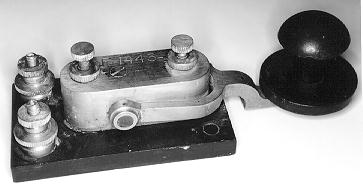
U. S. Navy SE-1443A Flameproof Spark Key:
This is another small flameproof spark key made and used by the Navy. [430] (W2PM collection)

Unusual German Spark Key:
This massive high-current key is marked: H.T. 3 No. 3362. [432] (W2PM collection)

Unusual German Spark Key:
This small spark key measures just 4-1/2 inches long. It’s lever and design is very similar to that of the key above. The purpose of the high wooden knob is not known for certain. It is possible that the key was used in German WW-I aircraft and that the high knob was easier to use by the heavily-gloved operator. [433]
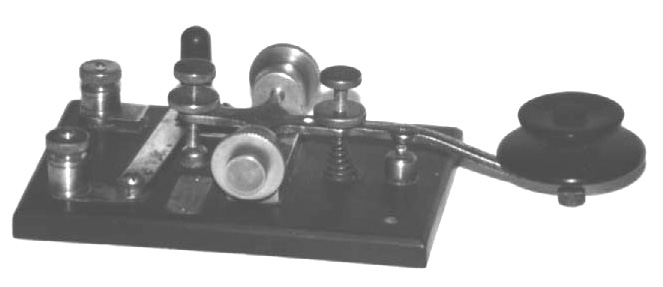
Federal Telegraph Co. Navy Key:
An unusual key made with a knob which is adjustable in height probably to allow telegraphers to use different operating styles. [434] (This key is in the W2PM collection)
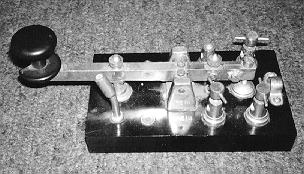
Japanese Wireless Key:
The straight lever design of this key has continued from the spark era, through WW-II to the present. This makes it difficult to tell when a particular example was made and used. If the key has a label, and If you can read Japanese, the key can be dated by reading the year of the emperor who was in power when it was built. [436] (w2pm collection) (The most recent models are made by Japanese Radio Corp., and carry the JRC Trademark-See #564.)

British Air Ministry Key:
This massive solid brass key has interesting, heavy, spring-mounted electrical contacts. As the key lever is depressed, the 1-1/2 inch silver contacts close and, at the same time, wipe diagonally against each other. This makes a more reliable contact and may reduce contact arcing. Light brown plastic cover. [438]

British Admiralty (Navy) key:
A massive Navy key with large contacts. [440] It was usually supplied with a pressed steel cover. (Pete Malvasi -W2PM)

Leach Spark Relay:
The Leach Company made an extensive line of spark relays which were designed to key the high-current primaries of spark transmitters. These relays allowed telegraph keys with small contacts to key very high current circuits. The relays even made it possible for operators to use semi-automatic keys or bugs to key their transmitters. [442]

Marconi Spark Relay:
This is a keying relay which allowed small-contact hand keys to operate high powered spark transmitters. [444] Although relays generally have little value, a relay carrying the "Marconi" name brings much higher prices.

Murdoch Spark Key:
This marble based spark key is one of the several brands that were used to key relatively low power transmitters such as those used by Amateur Radio Operators. [446]
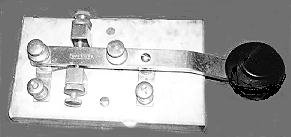
A. W. Bowman Spark Key:
This key was used by many amateur radio operators. It has a white marble base. It was sold as shown with the A.W.B. initials stamped on the lever. [448] It was also sold by Montgomery Ward, Sears, and other companies with no identifying marks. [448a]

Clapp-Eastham "Boston" Spark Key:
This was the ultimate spark key that every Amateur Radio Operator wanted. It was sold on a black base [450] and on a lovely marble base much revered by collectors. [450a]

Bunnell Spark Key:
This Bunnell key had a nice looking brass base with Mica-insulation. Notice the copper strip which connects the lever to the base for high current applications. It was a popular key and many were sold. [452]

Bunnell Spark Key:
This key had a Black base and a copper current-carrying strip like the key above The contacts could be unscrewed for easy replacement. [454]
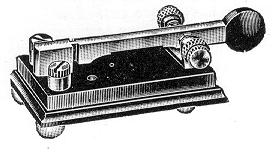
Bunnell Wireless "Sideswiper":
This hard to find key was similar to the land-line sideswiper designed to "cure" Telegrapher’s Paralysis. It had large, heavy contacts to switch the high current primaries of the spark transmitters. The fact that it is so hard to find indicates that not very many were sold. [456]
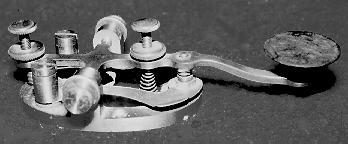
Bunnell "Triumph Style" Wireless and Radio Key:
Bunnell modified the land-line Triumph key for use in high current transmitter circuits. These keys have large contacts, a brass lever, and a copper strap between the base and the lever to carry the high current. Very Common. [458]

Signal Electric Co. Spark Key:
Also called the "Standard Wireless Key". An incredible number of keys with this design were made from the 1920’s to the present. The earliest ones were designed for keying high current primaries of spark transmitters. They can be identified by their 1/4" contacts and the mica insulation under the brass base. [460]
Homemade Spark Keys:
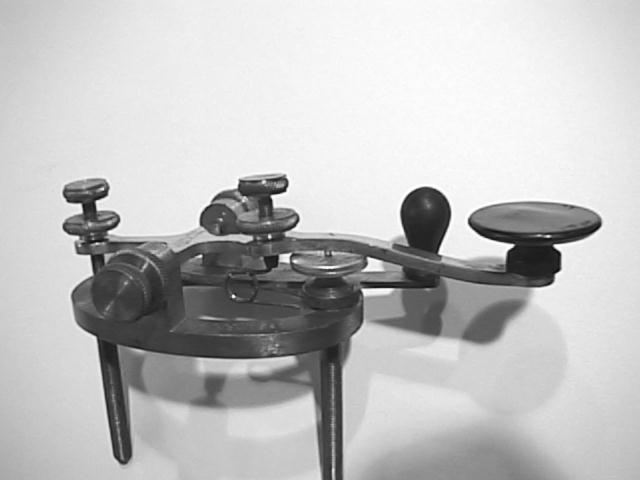
The "Dime Key":
Amateur radio operators were usually short on funds. Although they dreamed of having a magnificent Clapp Eastham "Boston Key", after they had paid for the other parts of their spark transmitters, they simply couldn’t afford one. Often they took an old land-line key and tried to use it instead. After they had burned the contacts all the way down, they would solder dimes to the remaining metal of the contacts. Since dimes were made of silver in those days, they made very good and durable contacts. The resulting keys were called "dime keys" and they are fairly common. [492]

Another Homemade Spark Key:
Amateur radio operators are known for their ingenuity. If they couldn’t afford a fancy spark key with large silver contacts, they made one out of what was at hand. The lever of this early Western Electric land-line key was extended out and away from the operator and a set of large contacts was arranged to carry the heavy current and dissipate the heat. [496] (Gerry Maira, KA2MGE collection)

A Bunnell Sounder that Became a Spark Relay:
This Bunnell sounder has large silver contacts mounted on the armature and the anvil.
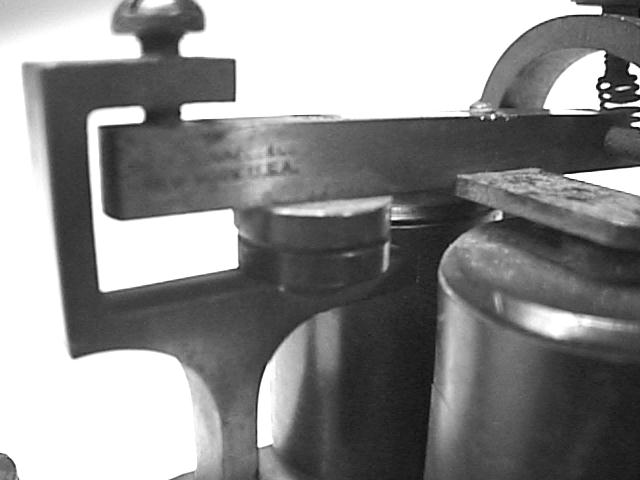
The contacts look as though they were factory installed but it is the only known example of such a modification that is known to exist and might have been done by Bunnell after it was made. [498]
RADIOTELEGRAPH OR "CW" KEYS: ( 1920’s - present)
Radio Transmitters Replace Spark Transmitters:
Spark Transmitters were outlawed in the early 1920’s because their transmissions could not be confined to a single frequency. They generated a broad spectrum of signals that interfered with other stations. Radiotelegraph transmitters which generated a single frequency continuous wave (CW) signal replaced the spark transmitters.
Radio Keys:
Keying these radio transmitters required much less current and the keys could be smaller than those used for the spark rigs. Although keying currents were small, radio keys sometimes had a resistor/capacitor network built into their bases to reduce contact pitting and sparking and prolong contact life. Spark keys continued to be used for a while, of course, but they were gradually replaced by the smaller and cheaper radio keys.

The Marconi Radiotelegraph Key:
Just as the Marconi Spark Key was the granddaddy of all spark keys, this magnificent Marconi Radio Key was the granddaddy of all radio keys. It’s massive European-style straight lever, ball bearings, excellent balance, and a built-in r/c network made it an instant favorite. [502] (W2PM Collection) A cover in good condition adds at least 20% to it’s value.

Mignon Radio Key:
This is a rare key [508] but it’s design is typical of many radio keys produced in the 1920’s - 1940’s. [508a]
McElroy Radio Keys: ( 1937 - 1984 )
Ted McElroy manufactured a very popular line of radio keys which are thoroughly described in Tom French’s book "McElroy" (see bibliography). Starting with a rectangular-based model, [520] he quickly shifted to an oval-based "Triumph-key" look-alike [522] and then introduced the first model of his VERY popular teardrop-shaped "Stream Key" in 1938.

McElroy Stream Keys: (First model)
The first Stream Key had a chromed teardrop-shaped base.
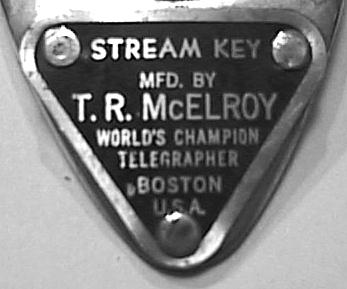
Its label reads: Stream Key. Mfg by T.R. McElroy World’s Champion telegrapher, Boston,USA [524]
McElroy Stream Keys: (2nd Models)
All of these second models of the Stream Key had much more rounded teardrop-shaped bases with no labels.

The "Deluxe" Model 300: All parts were chrome plated. [526]

The Professional Model 200: This key had a chromed lever and black wrinkle-finished base. [528]

The "Amateur" Model 100: This key had a cadmium-plated lever and black wrinkle-finished base. [530]
The Gray-Based Variant: (Not shown) Similar to the models 200 and 100 but with gray wrinkle-finish. [532]
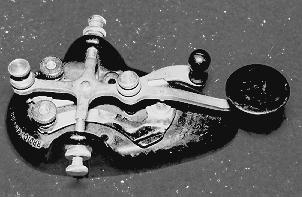
The Later "Amateur" Model 100 with Plastic Base.
This very inexpensive key has lettering cast into the plastic base which reads: "Stream Key. Manufactured by T.R. McElroy, Boston, Mass. USA." They are quite hard to find. [534]
WARNING ! Fake McElroy Keys !
Someone made thousands of exact copies of the popular McElroy Stream Keys. These copies were made with a very cheap "pot metal" casting. [536]
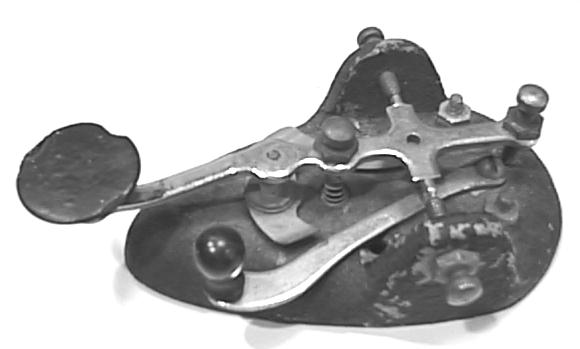
Cracks frequently develop around the upright portions of the base. (See below.) [536]
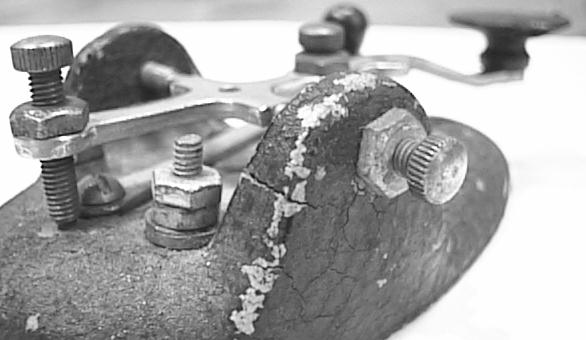
HOW TO IDENTIFY A "FAKE" McElroy Key
The only reliable way to identify this "counterfeit" key is to see whether the base is attracted by a magnet. If it is attracted, it is a genuine McElroy Stream Key. If not, it is a fake..

The McElroy-Like Canadian Grimmer-Wilson Radio Key:
This gray wrinkle-finish key looks suspiciously like the McElroy Stream Key. It was made for the Canadian Military and carries the number: 10F/556. [538]
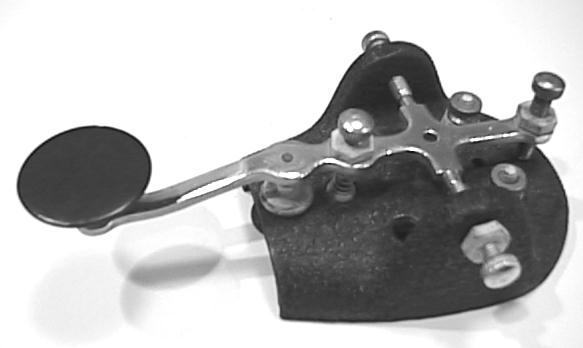
The Telegraph Apparatus Corp Code Practice Oscillator Key:
This key is a Model 100 metal-based stream key with its base cut off to fit inside a Telegraph Apparatus Co. (A McElroy Company) "Oscillatone" code practice oscillator. [540]
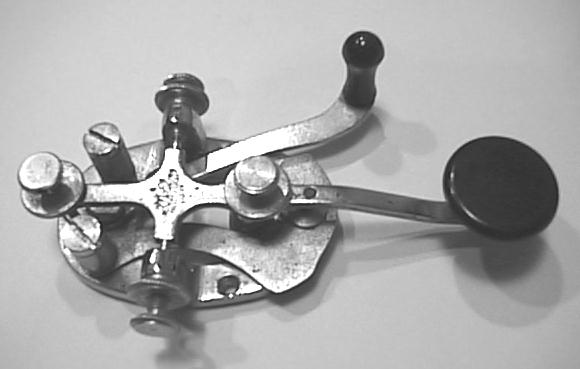
The McElroy "Professional Model Hand Key"
In 1965, long after Ted McElroy had died, John McElroy began production of a lovely chrome-plated all brass key. It was sold in a Silk-lined jewelry box along with a pin in the shape of a key. Only 100 were sold and production was discontinued... making this a very hard key to find. [542]
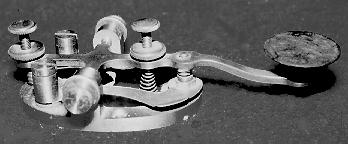
Bunnell Radio Keys:
Bunnell continued to manufacture their Triumph-style spark key [458] for radio use. [546] Notice how very similar it is to the McElroy above...
BUNNELL LOOK-ALIKE - ALERT!:
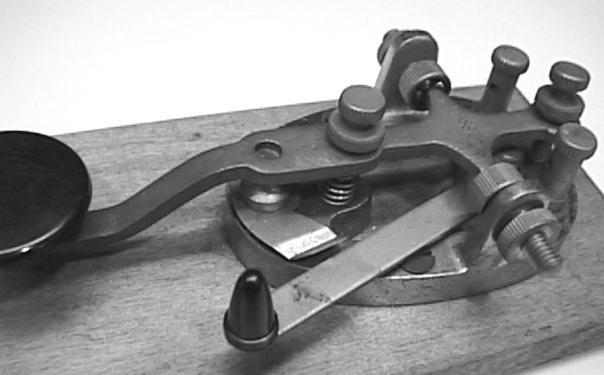
This Japanese key looks like a Bunnell radio key. But you can easily identify it by the ball-bearings. The contacts oxidize making for poor keying. Thousands of these keys have, and are, still being sold by Radio Supply Companies. VERY common. [548]

Signal Electric Radio Keys:
Signal Electric Co. continued to manufacture their spark key [460] for radio use. It had smaller contacts, no mica, and many different bases. The bases include the original brass, chrome, chrome-edged black, and black wrinkle-finish. (Shown) Very common. [550]
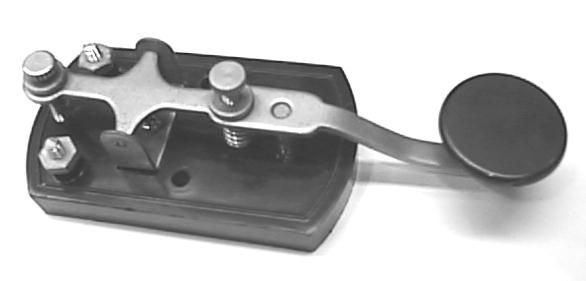
Signal Electric Co. Look Alike:
This extremely poor quality plastic copy of the Signal Electric Co. keys has, and is being sold in great quantities. The metal contacts do not close reliably and this makes for erratic keying. They are, perhaps, the most common of all keys. [552]

Speed-X Radio Keys:
Speed-X has been making a line of radio keys for many years. They range from this inexpensive plastic-based key [554] to some nicely made Bunnell Triumph-style keys with oval chromed [556] or oval black wrinkle-finished [558] bases.

Brown Brothers Radio Keys and Key-Keyer combinations:
Brown Brothers made a line of straight keys and straight key - keyer combinations that have become especially popular among the group of collectors who also use their keys on the air. [560]

"Ham Key" Radio Keys:
Ham Keys are quite common. They work well but they have not become popular among collectors yet. [562]
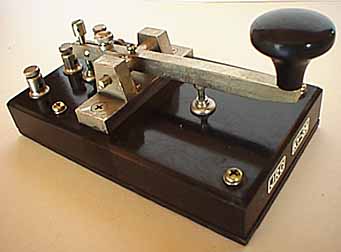
Japanese Radio Corp. "JRC" Keys:
JRC makes keys that are virtually identical to the earliest of the Japanese spark and wireless keys (see number 436). They have the classic European-style rectangular straight levers with tension or pull-down springs. [564]

The "Swedish Key":
This key is being produced in limited quantities in Sweden. It is patterned after the very early Swedish land-line keys and has a wonderful "feel". [570] Unlike most other keys, it has no trunnion shaft at all. Instead, a thin piece of spring steel acts as the support for the lever and flexes as the key is pressed. This is similar to the Steiner Key design (See No 118)
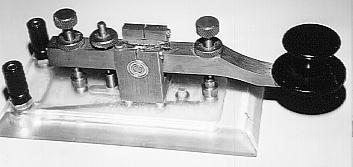
British Kent "Kit" Keys:
Kent keys are very nicely made with a massive European-style straight, ball-bearing-mounted lever and a pull-down spring. They are sold in various ways some of which allow the builder to add a base of their own design as shown here. Kent keys have such nice "feel" that they sell for almost as much "used" as they do new. [574]
Other "New" Keys:
A surprising number of individuals and companies are currently making a wide variety of innovative and interesting keys. The advertisements in the back of most ham radio magazines will introduce many of them and most have internet web sites which can be found by searching for "telegraph keys".